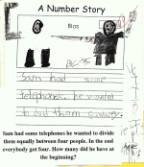
Phase 2– Inquiry
Pursuing Our Questions
Data Collection, Analysis, and Synthesis, and Evaluation

Students on a field trip to the post office.
Children pursued answers to their questions by engaging in data gathering, in Phase 2. In the Project Approach, children gather data by following the standard procedures of inquiry, such as: going on field trips, observing, interviewing experts, setting up experiments, and surveying. They recorded their data by making observational drawings, representations, and data displays. They predicted, observed, hypothesized, theorized, tested, analyzed, and evaluated their data. They shared their findings and discussed their understandings. Parents shared their expertise and contributed related artifacts for study.
Field Work
To begin the investigation, children thought about the first researchable question in Phase 1, What is communication and what are the ways to do it? Children predicted all the ways to communicate in and around our school. They listed in a random order:
| Weather Alarm TV Telephone Computer Police car Cell phone Mouth talking Facial expressions Letters |
Camera Smoke detectors Hands Body language Walkie-talkie Fire alarm Signs Chalkboard Plants |
Each child selected one of the items from the list on which to do an observational drawing. These observational drawings were used to make a tally sheet. Children predicted the number of computers in our school and then walked around making tally marks on the sheet every time they saw a computer. On the following day, the children analyzed the data that they had collected on their tally sheets. They interpreted the information and made a bar graph to show what they had seen. They communicated the results to the teacher and noted some mathematical relationships.
They pursued this data collection for each of the ways of communication that they listed. Then they reported their observations and discoveries back to the whole class. This exchange allowed for the children to clarify their thinking through discussion, ask questions, listen, challenge assumptions, and express their own knowledge about the topic at hand. A problem occurred after predicting and counting the signs. Children complained that one child had filled his whole paper up with tally marks, counting each sheet of paper in our school. A discussion was held to set criteria for what makes a sign.
Sign Characteristics
a. The words on a sign have to be big.
b. A sign has to have a shape that is noticeable.
c. A sign has to have pictures and/or words that say a message.
WJ wanted to know if a nametag would qualify as a sign. The words are
big. A nametag has a shape. The message is My Name is -----. The children
had the following conversation about whether or not a nametag should be
categorized as a sign.
| CS: No, a nametag is not a sign. It’s not big enough. WJ: We didn’t say it had to be huge. I think it is a sign. CS: No. Teacher: Would you like to see what the rest of the class thinks about this problem? We could ask them in a survey. (The children agreed.) |
To continue the in-depth study, children signed up for teams to investigate the remaining researchable questions from Phase 1:
|
Questions |
Study Teams |
|
1. What are the ways to send and receive messages and how do they work? |
Mail, Computers, Communicating face-to-face, Telephone, TV & Radio |
|
2. What are codes and signals and how do you learn them? |
Codes |
|
3. What does sound need to travel a distance? |
Sound |
Early in February, children made a valentine card for their family. The teacher asked what was the best way to get the card to their family.
| WJ: A mailbox. Teacher: Should I add that to our list? Do we have mailboxes around our school? |
Children talked about where the mailboxes were and how we would recognize them:
| BG: We have a post office building near our school. CM: It’s a square post box that’s white. WJ: I think the box is black. BG: It’s any color. No special color. JP: There’s a mailbox with a letter slide. It can be any color or maybe blue. KK: We have to look for a mail carrier. JM: They wear blue uniforms. WJ: No they wear white ones. NC: I’ve seen them wear black. |
Students predicted that they would see anywhere from 1 to 19 mailboxes. Then they walked around the school and counted 1 mailbox and 2 additional mail pick-ups. They predicted, counted and made observational drawings of the mailboxes.

JM doing an observational drawing of a mailbox.
To answer KK’s question, “What happens to valentine letters that don’t get delivered,” the children visited the post office and talked with the postmaster. The children wrote additional questions and predictions of how their questions would be answered.
|
Where do lost letters go and how
do you decide who works there?
|
|
Student's prediction of what happens
to lost mail.
|
|
Question |
Prediction |
Finding |
|
WJ: Do you deliver in rainy weather? |
When it rains, the mail carrier doesn’t deliver mail. They check the weather before they go out. |
They deliver mail in all weather. |
|
KS: Do letters get stuck in mailboxes? |
Letters get stuck in the bottom of the mailbox and do not get delivered. I think they should use a flashlight to look into the mailbox and see. |
The letters that do not get delivered are usually
missing something important like a stamp, or a name, rather than
stuck at the bottom of the mailbox. |
|
WJ: Do you have stairs? |
The postal workers slide down a pole. There are no stairs. |
There are stairs and even elevators. |
Children collected their data on the site visit. They each had a clipboard with their question, a tally sheet with chosen items to count (postal workers, sorting baskets, machines, computers, stamps, buttons on machines, and mail trucks), blank paper for observational drawings, and a camera. They interviewed several postal workers and wrote the answer or drew a picture of something that would remind them of the answer. Back at school, they shared their field experiences and compared their findings. Once the pictures were developed, the children recalled the trip, sequencing the events through photographs.

JN sequenced the pictures from the field trip
to the post office to share with the class.
Computers
The class seemed to be quite interested in computers. In Phase1, one-fourth of the class drew memory stories involving computers showing that they had some experience with computers. However, the categorizing discussion (Phase 1) indicated that most of the students were not clear about the difference between TV and computers and how the computer sends a message.
On 2/16/01 the team studying computers predicted how many computers were in our school. Their guesses ranged from 6 to 120. (The boy guessing 120 revised his number to 50 when he realized that our school did not include the whole building.) The children then counted the computers and completed observational drawings.
A computer programmer came to school on several occasions to talk to the small group and answer KK’s question, “How do computers send messages?” The students in the group took the computer apart, drew the inside, and predicted what the function was for each of the parts.

Making observational drawings of the inside of a computer.
Names were given for the parts of the computer and their function explained. This group also made observational drawings of people working on the computer. These drawings were included in the Communication in our School mural for Phase 3.

Making an observational drawing of
students using the computer.
Communicating face-to-face
The classroom instructional approach supports interactive roles. Children have opportunities to work with a variety of peers and teachers (one-on-one, small and large groups) and are encouraged to engage actively in discussions of the topic, exchange ideas, debate, etc. Children counted ‘mouth talking’ and facial expressions going on in the school. The small group reported how important looking at the person and really listening is to communicating.

Children actively listen to each other.
Children discussed miming. The class enjoyed miming in creative dramatics activities and Charades. Children in this small group represented by drawing and painting people engaged in face-to-face communication.
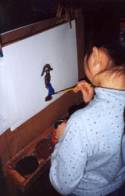
AH painting people communicating
face-to-face.
Students also learned that there are many different languages. Parents came in to teach French, Spanish, and Chinese. The Assistant Teachers taught Hebrew and Sign Language. The children discussed what communication means to those who are blind, deaf, or have a speech impediment.
TV and Radio
To answer JP’s question, “How does the TV get its channels?” A small group visited the TV station and interviewed the station manager. Some additional questions were generated.
NC : How fast can the stuff in the TV wire go (from the TV station to your home)?
CM: What's the limit a TV channel can have?
JB: Do radio waves have the same wire as television?
BG: How much talking is on one TV channel in one day?
AH: How does the TV show go to peoples’ houses?
JP: How do they decide what to put on each channel?
AK: How many wires are attached to a house TV?
NO: How does the radio get all of its channels? Do you make them in a factory?
Children collected their data and drew observational drawings at the television station. They shared their findings at the next group meeting.
Codes and Emergency Signals
To answer CS’s question, “How does the fire station receive a message from the fire alarm box in our room,” the children visited the Fire Training Institute. Children wrote additional questions and predicted how their questions would be answered. Children collected their data on the site visit. They interviewed firemen and drew a picture of something that would remind them of the answer for sharing at a later time.

JH interviewing the fireman on the field
visit to the Fire Training Institute.
Children wrote what they had learned at the Fire Institute. They represented and shared their thoughts with the class.

CS's block representation of a fireman.
A small group studied the emergency storm signal. BG’s question, “How does the emergency storm signal know to turn on and send us a message that there is a storm,” started a lively discussion. The small group, with a teacher, went searching for the signal tower near the school. The group predicted what might be the signal tower. But they had to wait until the first Tuesday of the next month when the signal sounded. On that day, the small group followed the sound, found the tower and interviewed the man checking on the signal. They made an observational drawing of the signal box and tower. All of the students followed emergency procedures during the storm drill and were very excited to listen to the information that the small study team reported upon their return to the classroom.
Interviewing Experts
Professionals came to the classroom to help answer children’s questions. Parents came to the classroom and spoke to the children to explain sound, how babies learn to talk, football codes, and how music communicates. Visitors included an audiologist, a manager of a telephone distribution store, a computer programmer, a flutist, a saxophone ensemble and experts using technology and sound.
A small group of children were interested in secret codes and Egyptian Hieroglyphics. They read information from the Internet and books. They enjoyed writing codes and sending messages to each other. A parent agreed to talk to the class about the codes he uses in the huddle for the University of Illinois football team.
Telephone
Seven of the questions asked in Phase 1 were about telephones.
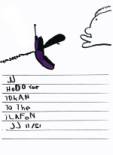
JM's drawing of a person talking into a telephone
accompanies his question about a cell phone.
"How can you talk on a cell phone with no wires?"
To answer questions such as, “How can you talk on a cell phone with no wires,” a telephone store manager brought old cell phones, telephone cables, and other telephone artifacts to school.
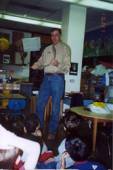
The telephone store manager showing a
telephone cable with glass wire inside.
Students asked additional questions. They predicted how they thought he would answer their question. Children made observational drawings of the cell phones.
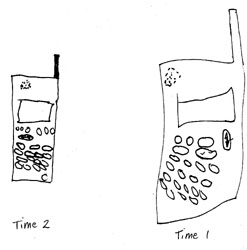
JH's observational drawings of a cell phone.
Children wrote math stories using communication devices as the subject. NC wrote his number story about telephones.

Number story with telephones written by a student.
The number stories had the author’s name removed. The stories were copied making them available for other children to solve. One child’s problem was the following: “Sam had some telephones. He wanted to divide them equally between 4 people. In the end everybody got 4 telephones. How many did he have in the beginning?”
|
BG calculates 4+4=8+4+4=16
|
|
AH attempts to solve the same
problem.
|
AH answers the number story with 20. In her math log AH tells how she solved this problem. Her math log still showed an inability to solve the problem abstractly. Later, the teacher provided plastic people and Unifix cubes to helped AH solve the story problem. With four groups of plastic people and Unifx cubes, AH completed the problem correctly.

The math log shows difficulty solving the problem
and provided an opportunity for the teacher to
develop another instructional strategy to help the
child understand.
Sound
Two students from the University came to the classroom weekly to help
explore electricity, sound, and communication with animals. Some children
investigated the wires on an electricity board to see a bell ring or a
light turn on or to send Morse code. Others made cup and string telephones
to better understand conditions for sound to travel along the string.

Children experimenting to see if sound travels
through string.
Children also experimented with communicating with a rabbit, the fish and worms. They tried putting colors and pictures in front of the animals to see any reaction. They tried facial expressions and hand movements. The most response from the fish was when food was involved. They thought worms reacted to light.
Children wondered about sound waves, (what they looked like, what could they go through and how they travel). They took a field trip to the Beckman Institute and two parents came to the classroom to make sound more visible to further students’ understanding of how sound travels. The experts brought tuning forks and water, singing bowls, and a slinky. Some of the equipment stayed at school for the children to continue to experiment and think about sound.

Children trying to see the sound waves move through the
slinky.
Some children had questions about music and sound. To help answer SJ’s question, “How does the sound come out of the instrument,” a flutist, percussionists and a saxophone ensemble answered questions about their instruments and sound. Children participated in music presentations that helped them answer WJ’s question, “Can music send vibration messages?”

A flutist visited the classroom to answer questions about
the
relationship between music and sound.
Communication Through Music
Studying communication as a project lends itself to music instruction. Children experienced many aspects of communication through music. They discussed conducting, themes and variations and movement to music as a form of communication. These activities usually took place during 20-30 minute whole group sessions.
The goals for music instruction included the following:
- Children will see music as a form of communication.
- Children will understand forms of communication through music.
- Children will become aware of musical features: beat, timbre and dynamics.
- Children will associate meanings with music.
- Children will think critically about music, express their conclusions, and explain their reasons.
- Children will solve problems in music.
Conducting
Orchestra conductors communicate their ideas to musicians by moving their hands and expressing with their bodies. Conducting activities concentrated mainly on beating two, three, and four beat bars.
Specific goals:
- Children will understand the role of a conductor and how he communicates with musicians.
- Children will understand the meaning of beats and rhythm.
- Children will be aware of changes in tempi.
- Children will learn to conduct two, three, and four-beat bars.
- Children will be able to distinguish between two, three and four-beat music.
Session 1: Introducing the role of a conductor and conducting two, three, four beat bars.
The graduate assistant, who is an accomplished violist, began the lesson by asking,
“Did you ever see an orchestra play? Who is it standing in front of an orchestra? What does he do? What does it mean?”
These questions lead to a discussion about the role of a conductor. After establishing conducting as a form of communication the next step was to learn some basic conducting.
The teacher began, “How do we conduct two, three, four-beat bars? What is the movement?” He asked the children to be conductors and continued, “ You conductors have to make it clear to a musician what rhythm you are beating, if its two, three, or four.”
After learning a set of movements, the teacher improvised a short piece on the viola on two, three, or four and the children conducted.
After establishing the down-up movement for two beat bars, and thus establishing basic understanding of the principle, the teacher demonstrated how to conduct three beats. Now that the children knew how to conduct on two, they were asked to find a clear way to conduct on three.
The teacher asked, “How am I as a musician in an orchestra supposed to know that you are conducting on three?” The children offered a few ways, (up-down-up, down-up-down, etc). After establishing the way to conduct on three (a triangle: down-outside-up, back to the starting point), and an improvised piece on 3, the same process applied to conducting on four. When asked to offer a way to conduct on four, the children offered a Square (down-outside-up-inside, back to the starting point). This is a logical evolution from the triangle for conducting on three. By reasoning the previous beats: first always down, last always up, one before last always outside, the movement for four-beat bar was established.
Session 2: Beating to different tempi.
The first activity was to repeat the movements learned in the last session by asking individual children to show the others the series of movements. After remembering each series of movements, the teacher played the viola and the children conducted.
The session concentrated on accelerating and slowing down the conducting movements together with music. This activity required flexibility from the teacher, to be able to perform in different tempi, and to follow up on children's reactions.
Session 3: Figuring out if music is on two, three or four.
As in the previous session, the children reestablished the movement sequences. They repeated the musical game of changing tempi.
The new activity was playing a game: “What is the beat?” The teacher played a piece of music, and the children tried to guess if it was on two, three, or four. Using the conducting tool allowed the children to find the beat to the music. This is a part of any musical dictation, and a basic feature of music.
Theme and variations
By writing or performing theme and variation pieces, composers and performers have a chance to communicate different feelings and ideas. Changing a simple tune from a major to a minor scale already constitutes a variation: happy - sad. Other possibilities include fast - slow, high - low, loud - soft, etc.
Specific goals:
- Children will understand the concept of theme and variations.
- Children will indicate a change in musical features: rhythm, pitch, dynamics, etc.
- Children will be able to apply acquired knowledge to new musical themes.
- Children will critically judge a performance using the newly acquired concepts.
Session 1: Introducing the concept of theme and variations.
The teacher played selections out of the second movement of F. Schubert's “Death and Maiden Quartet.” The movement was in a form of theme and variations. After listening to the theme, the teacher asked, “What do you think the composer is trying to communicate to us, the listeners? Are there any feelings in the music? Does it make you feel something? What does it make you feel?” Children engaged in a lively discussion to answer those questions.
The next stage was to listen to some of the variations, again in short excerpts. After listening to each variation, the class tried to establish what the composer did, and if they could still recognize the theme through the different variations.
Session 2: The kind of variations we can make.
The students chose "Mary Had A Little Lamb” for the theme on which the teacher based the variations. First the teacher played the tune, and then the students sang it. Then the teacher started to variegate. The first variation was from the major to the minor key. This was done in technical terms by changing specific notes. He asked the students, “What did I do? What did I change?”
This was not easy for some of the students and the teacher had to perform the original and then the variation again a few times. Then a student said: "It was happy and now it's sad.”
The teacher asked: "What did I do to make it sound sad?" After a short discussion, we discovered that changing only a few notes made a big difference. Other variations tried in this session were: fast, slow, high, low, loud and soft. Then they tried a variation with the children singing and the teacher playing and ornamenting the tune.
Session 3: Children suggesting variations.
This session's goal was to apply the knowledge learned in the previous sessions to a new setting. The teacher asked the students to choose a song. They chose "Twinkle, Twinkle Little Star.”
As in previous sessions, the teacher first played the tune, and then the children sang. The teacher then asked for suggestions. A child offered: "fast", another offered: "slow.”
One said, "sad, " and another said "Change 5 notes" (referring to the change from major to minor changing only a few notes in the previous session).
After the more difficult variations, the teacher asked, "Did I do a good job? Could you hear the difference? Did you like how I played?” The goal of these questions was to have the children listen critically to the teacher's playing, and to try and have them explain their conclusions.
Movement to music as a form of communication
Music expresses ideas not only by itself, but also as a supplement to a dance. Composers write music for ballet and tell a story through music and movement.
Specific goals:
- The students will understand the connection between movement and music.
- The student will know that by moving to music they can communicate ideas.
- Children will solve problems of communicating through their body movements.
- Students will think critically about their movements, and will learn from others'.
As modern dance is not necessarily performed to ballet music, we took the liberty and applied movement and a story to R. Schumann's "Fairy Tales." These were two sessions in which the students were offered an opportunity to perform in small groups in front of the rest of the class. Each group was given a chance to listen to the part of the story that they were going to dance to and then the teacher played the music for them to plan their movements.
The story was a simple fairy tale:
- In the first movement the knight is getting ready to go to war. He is saying goodbye to his wife, his children, and his dog.
- In the second movement the knight is riding to battle on his horse.
- The third movement is the battle scene.
- In the fourth movement a sad and injured knight is riding back home, to see his wife, children and dog.
The children in the audience had to guess what each performer was trying to communicate. Who were the characters, what were they feeling and doing. All children chose to perform, and many commented.
“I liked what JH did.”
“He was the knight.”
“She was fighting with a sword.”
“JM was hurt in battle so he was limping.”
“I was not only the Knight. I was also his horse and I was hurt in the battle.”
These sessions gave the children an opportunity to express themselves through movement. Students also learned from others and thought critically about the movements. They engaged in problem solving when they figured out how to communicate their feelings and actions clearly to their audience.
As the year came to an end, the students wanted to share the communication project with parents, family and friends. They moved on to Phase 3 and planned their Spring Open House as a culminating event.
|
|
 |
||
|
STUDYING
CONSTRUCTION |
EXPLORING
COMMUNICATION |
© 2001. University
Primary School. Department of
Special Education. University of Illinois.
All rights reserved. Credits.



